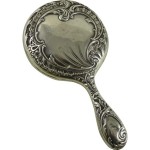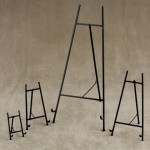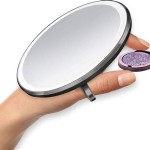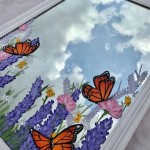Leather Mirrors for Wall Décor: A Guide to Style, Selection, and Installation
Mirrors are fundamental elements in interior design, serving not only a functional purpose but also significantly impacting the aesthetic of a space. They can enhance natural light, create the illusion of spaciousness, and serve as decorative focal points. While traditional mirrors often feature simple frames or frameless designs, leather-framed mirrors offer a distinctive and sophisticated alternative. A leather mirror on a wall introduces texture, warmth, and a sense of luxury, complementing a wide range of interior design styles from rustic and bohemian to modern and minimalist.
This article will explore the characteristics, benefits, and considerations involved in selecting and installing leather mirrors for wall décor. It will cover various styles, material options, installation techniques, and maintenance guidelines to provide a comprehensive understanding of this unique design element. The content will focus on providing objective information to assist readers in making informed decisions about incorporating leather mirrors into their homes or businesses.
Aesthetic Versatility and Design Styles
Leather-framed mirrors are available in a diverse array of designs, allowing for seamless integration into various design themes. The inherent textural quality of leather introduces a tactile element that contrasts with the smooth reflective surface of the mirror, creating visual interest. The style of a leather mirror is primarily defined by the type of leather used, the stitching details, the shape of the mirror, and any embellishments.
For rustic or farmhouse-style interiors, leather mirrors with thicker, distressed leather frames and visible stitching details are particularly well-suited. These mirrors often feature a natural, raw aesthetic that complements exposed wood beams, stone accents, and other rustic elements. The leather can be treated to appear aged, adding to the overall character of the space.
In contrast, modern and minimalist designs benefit from leather mirrors with clean lines and smooth, refined leather frames. These mirrors often incorporate subtle stitching or no stitching at all, emphasizing the sleekness of the design. Neutral-toned leather, such as black, white, or gray, is commonly used to maintain the understated elegance characteristic of minimalist interiors. The geometric shapes, such as squares, rectangles, and circles, are frequently encountered in modern applications.
Bohemian and eclectic spaces offer an opportunity to experiment with more unconventional leather mirror designs. These might include leather mirrors with intricate patterns, colorful leather accents, or unique embellishments such as studs or tassels. The key is to find a leather mirror that reflects the personality and vibrancy of the overall design scheme.
Beyond general style categories, consider the specific room in which the leather mirror will be placed. In a living room, a large, statement-making leather mirror above a fireplace or sofa can serve as a dramatic focal point. In a bedroom, a smaller, more intimate leather mirror might be appropriate for a vanity or dressing area. In a bathroom, ensure the leather is treated to resist moisture and consider the overall lighting scheme to maximize the mirror's reflective capabilities.
Material Considerations: Leather Types and Quality
The quality and type of leather used in a leather mirror frame significantly impact its appearance, durability, and overall value. There are various types of leather available, each with distinct characteristics and price points. Understanding these differences is crucial for selecting a leather mirror that meets both aesthetic and functional requirements.
Full-grain leather is considered the highest quality of leather. It is made from the entire grain of the hide and retains all of its natural markings and imperfections. Full-grain leather is exceptionally durable and develops a rich patina over time, adding to its character. Leather mirrors framed with full-grain leather are typically more expensive but offer superior longevity and visual appeal.
Top-grain leather is the second-highest quality of leather. It involves sanding away imperfections from the surface of the hide and applying a finish. While not as durable as full-grain leather, top-grain leather is still a high-quality option that is more uniform in appearance. Leather mirrors framed with top-grain leather offer a good balance between quality and price.
Split-grain leather is made from the lower layers of the hide after the top layers have been removed. It is typically less expensive than full-grain and top-grain leather but is also less durable. Split-grain leather is often used to create suede or embossed leather finishes. Leather mirrors framed with split-grain leather may be a more budget-friendly option, but it is important to consider their reduced lifespan.
Bonded leather is the lowest quality of leather and is made from scraps of leather that are bonded together with adhesives. It is significantly less durable than other types of leather and tends to crack or peel over time. Leather mirrors framed with bonded leather are typically the least expensive option, but their poor quality makes them unsuitable for long-term use.
In addition to the type of leather, the finish applied to the leather also influences its appearance and durability. Leather can be treated with waxes, oils, or dyes to achieve different colors, textures, and levels of water resistance. It is essential to choose a leather finish that is appropriate for the intended use of the mirror, particularly if it will be placed in a high-moisture environment such as a bathroom.
When assessing the quality of a leather mirror, examine the stitching details, the smoothness of the leather, and the overall craftsmanship. Tight, even stitching indicates a well-made product, while loose or uneven stitching may suggest poor quality. The leather should feel supple and smooth to the touch, without any signs of cracking or peeling.
Installation Techniques and Maintenance
Proper installation is crucial for ensuring the stability and longevity of a leather mirror. The installation method will depend on the size and weight of the mirror, as well as the type of wall on which it will be mounted. It is essential to follow the manufacturer's instructions carefully and to use appropriate hardware for the specific installation.
For smaller, lightweight leather mirrors, adhesive mounting strips or hooks may be sufficient. These options are easy to install and do not require drilling into the wall. However, they are not suitable for heavier mirrors or walls that may not provide a strong enough bond. Ensure the adhesive is specifically designed for use with mirrors and that the wall surface is clean and dry before application.
For larger or heavier leather mirrors, it is necessary to use screws and wall anchors. Locate the wall studs and use screws that are long enough to penetrate the studs securely. If studs are not available in the desired location, use wall anchors that are appropriate for the type of wall (e.g., drywall, plaster, concrete). Ensure the anchors can support the weight of the mirror and that they are properly installed according to the manufacturer's instructions.
When hanging a leather mirror, use a level to ensure it is perfectly straight. Mark the locations for the screws or hooks on the wall and use a drill to create pilot holes if necessary. Carefully hang the mirror on the screws or hooks, ensuring it is securely attached to the wall.
Maintaining a leather mirror involves regular cleaning and care to prevent damage and preserve its appearance. Dust the leather frame regularly with a soft, dry cloth to remove dirt and debris. Avoid using harsh chemicals or abrasive cleaners, as these can damage the leather finish.
For deeper cleaning, use a specialized leather cleaner and conditioner. Apply the cleaner to a soft cloth and gently wipe the leather frame, following the manufacturer's instructions. After cleaning, apply a leather conditioner to moisturize the leather and prevent it from drying out or cracking.
Protect the leather mirror from exposure to direct sunlight, as prolonged exposure can cause the leather to fade or discolor. Avoid placing the mirror in areas with high humidity or moisture, as this can lead to mold or mildew growth. If the leather becomes wet, dry it immediately with a soft cloth.
By following these installation and maintenance guidelines, individuals can ensure that their leather mirror remains a stylish and functional addition to their interior décor for many years. The initial investment in a quality leather mirror and the consistent application of proper care techniques will contribute to its longevity and continued aesthetic appeal.

Large Leather Mirror Frame Wall Curiosity Interiors

Leather Mirror Wall Hanging Curiosity Interiors

Heath Rectangular Brown Leather Mirror

Leather Mirror Frame Wall Curiosity Interiors

Equestrian Round Leather Strap Loop Mirror

Xramfy 24 In W X H Round Mirror With Hanging Leather Strap Aluminum Frame Black Wall Rmls24 The Home Depot

Reversible White Cowhide Leather Rectangle Wall Mirror Loomlan

Leather Wall Mirrors For At 1stdibs

Ben Metal Mirror Round Leather Strap Elevenpast

Italian Designer Oval Crocodile Leather Mirrors Sharing Beautiful Home Decor Inspirat Mirror Wall Bedroom Living Room








